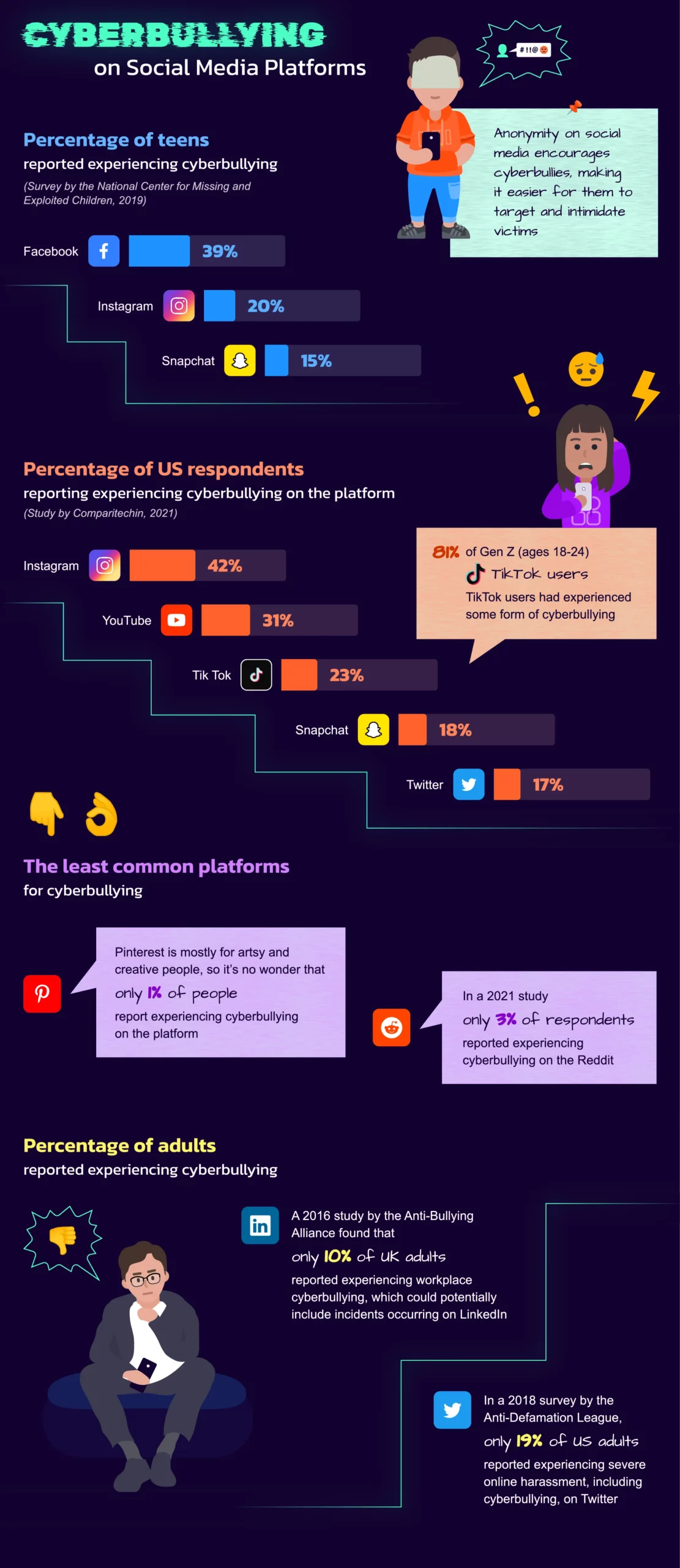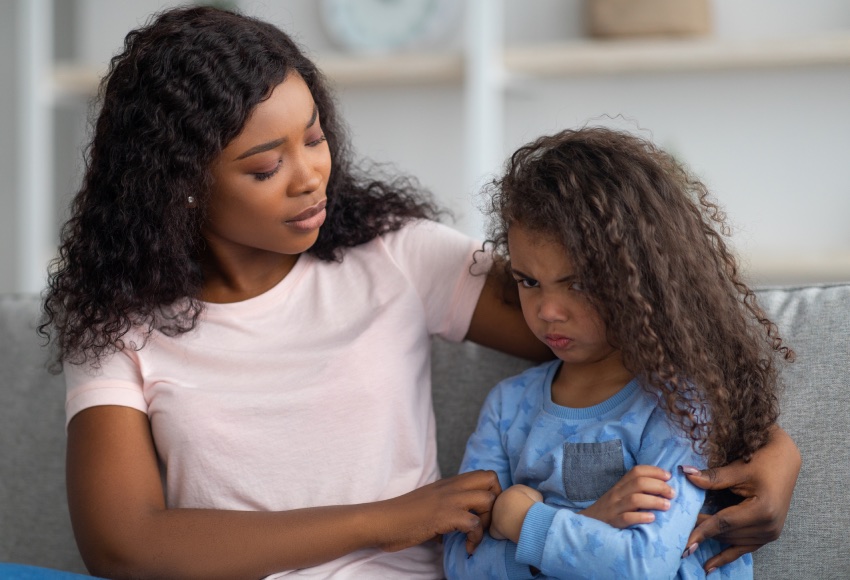
Bullying is one of the most concerning things your child can experience. With the advancement of technology and almost everything done online, cyberbullying has become parents and their children’s worst nightmares.
The worst part of it all isn’t the act of bullying but the long-term effect it will cause—imagine a child questioning their self-worth, crying out of self-pity, and believing that there’s something wrong with them.
Not only in the long-term psychological effects but also in the child’s safety. Child predators and online sexual harassment can also be tied to cyberbullying in the case of blackmail.
Over the past decades, the number of cases related to cyberbullying hasn’t gotten any better. Every day, the numbers add up. Worse, some of these cyberbullying victims ended up taking their own lives.
Saving your child from cyberbullying and teaching them how to handle such situations is such an overlooked matter. Even schools don’t have much power to stop such things. However, for parents or guardians to be able to help their children, we should first identify the most likely way a child can be bullied online.
What is Cyberbullying?
Cyberbullying is using digital communication platforms, like social media, messaging apps, or online forums, to harass and intimidate others. It encompasses a series of deliberate and repeated aggressive behaviors specifically aimed at individuals or groups to cause emotional distress, embarrassment, or humiliation.
Sending threatening or derogatory messages, spreading rumors or lies, sharing embarrassing or manipulated photos or videos, and excluding or ostracizing someone online are various types of cyberbullying.
It can have severe emotional, psychological, and social consequences for the victims, making it crucial to address and prevent cyberbullying to ensure the safety and well-being of individuals, particularly children.
Why does Cyberbullying occur Among Children?
Cyberbullying among children is a multi-faceted issue that can be attributed to a variety of factors.
According to a 2018 Pew Research Center survey, 95% of teens reported having access to a smartphone, and 45% said they are online “almost constantly,” thereby increasing their exposure to potential online harassment.
Factors contributing to cyberbullying among children include anonymity, power dynamics, a lack of empathy, and bystander behavior. The perceived anonymity of online interactions can embolden bullies, as they will be protected.
Power dynamics are also crucial, with bullies often selecting targets they perceive as vulnerable. A 2019 study by the Cyberbullying Research Center reported that perceived power imbalances contributed to nearly 30% of cyberbullying incidents.
The truth is that each child grows up in a different environment and has a unique upbringing. What’s happening inside their homes will eventually show in how they behave and treat others.
Let’s narrow down and focus our lens on how social media platforms have become a medium for cyberbullying and accelerate its cases.
Cyberbullying on Social Media Platforms

Here is a look at the statistics of bullying online that a child can experience at any time.
1. Facebook
With a population of 2.989 billion, Facebook is undoubtedly the largest social media platform in the world. With that number, it’s no wonder why most of the bullying online happened through the platform.
According to a survey conducted by the National Center for Missing and Exploited Children in 2019, Facebook was the platform on which the highest percentage of teens reported experiencing cyberbullying (39%), followed by Instagram (20%) and Snapchat (15%).
Similarly, a 2020 study by Comparitech found that Facebook was the platform with the highest number of reported incidents of cyberbullying in the US, with 59% of respondents reporting experiencing cyberbullying on the platform.
2. YouTube
YouTube is another popular social media and content creation platform where cyberbullying can happen.
A 2019 study by the Pew Research Center found that 81% of US adults reported using YouTube, and 15% reported experiencing online harassment on the platform.
YouTube was the second most common platform for cyberbullying in the US, with 31% of respondents reporting experiencing cyberbullying on the platform, as shown in the 2021 report by Comparitech.
3. Instagram
Unlike YouTube, which contains only videos, and Facebook, which has all sorts of entertainment, Instagram, on the other hand, is known for posting photos online. It could be your life updates, a selfie, or something that you just wanted to show the world. However, it’s also the host of many cyberbullying cases.
In fact, the 2019 National Center for Missing & Exploited Children survey found that 20% of teens reported experiencing cyberbullying on Instagram.
Furthermore, a 2021 study by Comparitech also found that Instagram was the most common platform for cyberbullying in the US, with 42% of respondents reporting experiencing cyberbullying on the platform.
4. TikTok
TikTok is another popular social media app that focuses on creating short-form content. The platform is also heavily crowded with creative people and social media influencers creating different forms of content. However, the platform is not at all safe.
In fact, 81% of Gen Z (ages 18-24) TikTok users had experienced some form of cyberbullying on the platform.
Similarly, a 2021 report by Comparitech also found that TikTok was the third most common platform for cyberbullying in the US, with 23% of respondents reporting experiencing cyberbullying on the platform. Well, it’s not at all surprising, as the US is one of the most active users of the platform.
5. Snapchat
Snapchat can also be a source of cyberbullying.
According to the 2019 National Center for Missing and Exploited Children survey, 15% of teens reported experiencing cyberbullying on this platform.
Moreover, Snapchat was the fourth most common platform for cyberbullying in the US, with 18% of respondents reporting experiencing cyberbullying on the platform, as reported by Comparitech, 2021.
6. Pinterest
Pinterest is mostly for artsy and creative people, where they can share, sell, or buy wonderful images or downloadable digital resources, such as templates.
That’s why it’s no wonder that only 1% of people report experiencing cyberbullying on the platform, as reported in the 2019 Cyberbullying Research Center.
7. Reddit
In a 2021 study by Comparitech, only 3% of respondents reported experiencing cyberbullying on the platform.
Like Pinterest, the platform was the least common platform for cyberbullying in the US.
8. LinkedIn
While LinkedIn is a social media app, it primarily caters to professional networking as well as finding jobs. A 2016 study by the Anti-Bullying Alliance found that 10% of UK adults reported experiencing workplace cyberbullying, which could potentially include incidents occurring on LinkedIn.
9. Twitter
In a 2018 survey by the Anti-Defamation League, 19% of US adults reported experiencing severe online harassment, including cyberbullying, on Twitter.
Apart from that, a 2021 report by Comparitech also shows that Twitter was the fifth most common platform for cyberbullying in the US, with 17% of respondents reporting experiencing cyberbullying on the platform.
The Most Likely Ways Your Child can be Bullied Online

Here’s an in-depth exploration of the most likely ways your child can be bullied online:
1. Mean comments
Insults, name-calling, and humiliating comments are among the most common forms of cyberbullying. A 2019 Pew Research Center study found that 42% of US teens experienced offensive name-calling online.
2. Rumor spreading
Spreading rumors just to damage a person’s reputation is another form of cyberbullying, which 32.8% of students have experienced, as reported by the Cyberbullying Research Center.
3. Exclusion
Intentionally excluding someone from online groups or activities can be a form of cyberbullying. The 2019 Pew Research study found that 32% of teens had experienced this behavior.
4. Cyberstalking
Monitoring or tracking someone’s online activities with the intent to harass or intimidate can also be a form of cyberbullying. According to a study published in the Journal of School Violence, 26.7% of middle and high school students experienced cyberstalking.
5. Identity theft
Pretending to be someone else online to harm or humiliate them is another form of cyberbullying that 21% of teens have experienced.
6. Sharing private information
Distributing private or sensitive information, such as images or personal details, with the intent to make fun of or destroy someone’s reputation is a common form of cyberbullying.
7. Harassment
Repeatedly sending threatening or offensive messages is another form of cyberbullying, which 12.1% of students experienced.
8. Flaming
A study published in Computers in Human Behavior found that 11.8% of adolescents engage in heated, aggressive online arguments, often using offensive language.
9. Impersonation
Creating fake accounts or profiles to harass or embarrass someone is another form of cyberbullying. The 2019 Pew Research study found that 9% of teens had experienced such a form of cyberbullying.
10. Dissing
Dissing is another form of cyberbullying that involves publicly denigrating or disrespecting someone online. It involves using derogatory language, insults, or negative comments to belittle or humiliate the targeted individual.
There are many possible ways your child can be bullied online. Just a few seconds of posting something about someone on social media platforms like Facebook or Instagram can already shake someone’s self-esteem, destroy someone’s peace, or worse, damage their reputation.
Apart from that, cyberbullies may resort to sending threatening messages or engaging in blackmail through private messaging apps. Private messaging platforms provide bullies with a direct and private means to intimidate and coerce their victims, causing fear and distress. Worse, some of these acts would lead to sextortion, a growing concern over the safety of minors, especially students, where 1 in 4 students under the age of 13 on average have been victims of such a case.
Learning about cyberbullying goes both ways for your child—teach them about using social media platforms responsibly so they will not become bullies, and teach your child to be open with communication so as to address such an awful act.
Signs that Your Child may be a Victim of Cyberbullying
Is there a sudden change in your child’s behavior? Are they behaving differently in recent days, and you think your child might need help? It’s possible that they may have been victims of cyberbullying. Below are some of the signs that this could be the case.

1. Emotional and Behavioral Changes
According to a 2019 survey by the Cyberbullying Research Center, about one-third of middle and high school students who had experienced cyberbullying reported feeling depressed, with many of them also experiencing severe emotional distress.
2. Changes in Online Activity
The same 2019 Cyberbullying Research Center survey found that approximately 37% of students who experienced cyberbullying changed their use of social media or technology as a result, often either withdrawing or becoming excessively involved online.
3. Performance Decline in School
A study published in the Journal of School Health in 2019 found a strong correlation between cyberbullying victimization and poor academic performance. Around 28% of those who reported being cyberbullied also reported poor academic performance.
4. Unexplained Anger or Frustration after Internet Use
According to the National Crime Prevention Council, about 33% of all teenagers who have been cyberbullied showed aggressive behavior and frustration, particularly after using the internet.
5. Secrecy About Online Interactions
A report from the Pew Research Center in 2018 found that 61% of teens have at some point decided not to post something because they were worried about what others might say or think about them. This might be an indicator of secrecy due to cyberbullying or other negative online experiences.
6. Sudden Loss of Friends or Social Status
Cyberbullying can lead to a child losing friends or being socially isolated. A child may be excluded from social events or shunned by peers as a result of rumors or embarrassing information spread online. According to a report by the National Academies of Sciences, Engineering, and Medicine in 2016, children who were cyberbullied reported higher levels of social isolation, with a strong correlation between cyberbullying and decreased social acceptance.
7. Health Issues
Cyberbullying can lead to both physical and mental health issues. Victims may suffer from sleep disorders, eating disorders, or chronic stress. The Centers for Disease Control and Prevention (CDC) stated in their 2019 Youth Risk Behavior Survey that nearly 16% of high school students who reported being cyberbullied also reported significant difficulties with sleep. Furthermore, a review published in JAMA Pediatrics in 2018 found a significant association between cyberbullying and both depressive symptoms and suicidal ideation.
If you believe that your child may be a victim, below are some of the best strategies to help address online bullying. Make sure that you practice these with your child so as to prevent cyberbullying in the future.
Strategies To Help Parents Prevent and Address Online Bullying
Knowing what cyberbullying is and the most likely ways your child can be bullied online isn’t enough. Learning how to handle it should also be taught. Your child may need it immediately, so knowing how to address such a problem is important.

1. Letting your Children Know it’s Not Their Fault
Make sure you show your child appreciation and hammer in on the fact that it’s not their fault they are being bullied. Let them know that you stand united and you support them no matter what happens.
2. Establishing open communication channels with your child
Maintain open and non-judgmental communication with your child, encouraging them to share their online experiences. By fostering trust and understanding, they will be more likely to seek help if they encounter bullying.
3. Setting and enforcing digital boundaries
Establish clear rules and guidelines regarding online behavior, including appropriate content sharing, interacting with others, and time spent online. Consistently enforce these boundaries to ensure your child’s safety and well-being.
4. Educating children about responsible online behavior
Teach your child the importance of treating others with respect and kindness online. Emphasize the potential impact of their words and actions, encouraging empathy and responsible digital citizenship.
5. Monitoring online activities without invading privacy
Regularly monitor your child’s online activities, but ensure you balance protecting them and respecting their privacy. Use parental control tools, supervise their online presence, and stay aware of their online friendships and interactions.
6. Encouraging reporting and seeking help when bullying occurs
Create a safe environment where your child feels comfortable reporting any instances of online bullying. Encourage them to save evidence, block or ignore the bully, and seek help from trusted adults, such as parents, teachers, or school counselors. Assure them that they are not alone and that support is available.
Long-Lasting Emotional Consequences and Possible Offline Impact
It’s no secret that online bullying can have profound and long-lasting emotional consequences for children. All those hurtful words, public humiliation, and relentless harassment inflicted upon them can leave deep scars on their mental well-being. The constant exposure to negative comments and derogatory messages can erode their self-esteem, self-confidence, and overall sense of self-worth.
One of the most alarming aspects of online bullying is its potential to spill over into the offline world. The effects of cyberbullying can extend beyond the digital realm and infiltrate a child’s physical life, impacting their relationships, academic performance, and even their physical health.
The stress, anxiety, and depression caused by online bullying can manifest in various ways, leading to decreased concentration, withdrawal from social activities, and declining grades.
Moreover, online bullying can tarnish a child’s reputation, both online and offline. Hurtful comments, embarrassing photos or videos, and false rumors spread through social media platforms can damage their image among peers and in their community. This can lead to social exclusion, isolation, and a sense of alienation from their support networks. In some cases, online bullying has even resulted in severe offline consequences, such as self-harm, suicide, or acts of violence. The relentless and pervasive nature of cyberbullying can push vulnerable children to their breaking point, as they may feel trapped and unable to escape the torment. It is crucial to recognize the potential seriousness of online bullying and take immediate action to prevent such tragic outcomes.
Parents, educators, and society as a whole must understand the emotional toll that online bullying can have on children and work together to combat it. Creating a safe and supportive environment, both online and offline, is essential for children to thrive and develop healthy self-esteem. This includes fostering open communication, providing emotional support, and teaching resilience and coping strategies to help children navigate the challenges they may face online.
By addressing the long-lasting emotional consequences and potential offline impact of online bullying, we can raise awareness and take collective action to protect our children from the harmful effects of cyberbullying. Together, we can create a safer and more compassionate online space for all young individuals.
Resources and Support for Parents and Children
Support in this matter should be readily available to parents or guardians. This isn’t only for the victims but also for the perpetrators of such acts. Here are some resources you can contact to report cyberbullying and ask for help:
LinkedIn – [email protected]
Telegram – [email protected]
Zoom – [email protected]
Here are some other key resources to consider:
- Parental Control Software: Installing parental control software on devices can help parents monitor and manage their child’s online activities. These tools often provide features such as content filtering, time restrictions, and activity tracking, allowing parents to create a safer online environment.
- Online Safety Education: Organizations and websites dedicated to online safety, such as the National Online Safety (NOS) and Common Sense Media, offer comprehensive guides and educational materials for parents and children. These resources cover topics like safe internet use, privacy protection, and dealing with cyberbullying.
- Reporting Mechanisms: Most social media platforms and online communities have reporting mechanisms in place to address instances of bullying. Encourage your child to report any incidents of cyberbullying they encounter, and familiarize yourself with the reporting procedures to ensure swift action can be taken.
- Counseling and Therapy: If your child is experiencing emotional distress due to online bullying, consider seeking professional counseling or therapy services. Therapists experienced in dealing with cyberbullying can provide the necessary support and guidance to help your child navigate their emotions and develop resilience.

Also, ask for contacts in your city’s local authorities. Remember, you could always be one of the people to help stop cyberbullying today.
The Bottom Line
Cyberbullying is a serious issue affecting children, with long-term emotional and psychological consequences. Social media platforms and messaging apps are common avenues for online bullying, including public harassment and privacy threats. Spreading rumors and gossip online also contributes to the problem. Parents and guardians must establish open communication with their children, educate them about responsible online behavior, and encourage reporting and seeking help when bullying occurs.
Social media is designed for communication and entertainment. So as a responsible user, only use it for its intended purpose. If you’re a parent, educate your child on the proper use of such platforms. Be responsible and take a step toward preventing cyberbullying!
